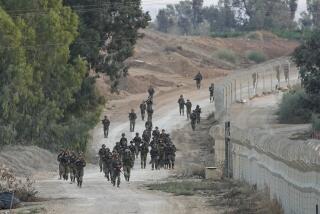Use More Common Sense, Less Faulty Intelligence
- Share via
The disastrous attack on the Chinese embassy in Belgrade, allegedly caused by the CIA’s lack of an up-to-date map of the city, serves as a crude reminder of the fundamental fallacy underlying all strategic bombing campaigns: Intelligence on targets always lags behind the enemy’s ability to react to the attacks.
Throughout the 20th century, successive aerial offensives have been launched with high expectations that this time the enemy’s “critical nodes” have been identified and can be destroyed, leading inexorably to his speedy collapse. Invariably, success eludes the bombers.
In the early weeks of the Gulf War, the U.S. repeatedly struck at “command and control” bunkers in which, it was fondly hoped and assumed, Saddam Hussein was lurking. No such luck. As the first bombs fell, the Iraqi dictator relocated to an anonymous house in the middle-class al-Tafiya district of Baghdad, where he passed the war unmolested. Ultimately the U.S. bombed a “command and control bunker” that had been turned into a civilian shelter and killed more than 400 civilians. As a result, further attacks on central Baghdad had to cease.
While bombs rained down on the Ho Chi Minh trail during the Vietnam air campaign, the enemy simply found new routes through the jungle. For years, the U.S. attacked a “vital” bridge at Thanh Hoa, in North Vietnam, (losing over 70 airplanes in the process) entirely ignorant of the submerged bridge put in place in the first month of the attacks. In “Operation Strangle” in Italy in World War II, the bomber commands attempted to choke off all rail traffic to the German front lines, unaware that the Germans were simply rolling out temporary bridges every night.
As each such failure is revealed, the theologians of bombing search for technical solutions--more accurate bombing methods, more comprehensive data on the targets. Invariably, it transpires that the knowledge of the enemy’s plans have once again proved inadequate. In the war against Serbia, NATO initially assumed that Slobodan Milosevic merely required a whiff of aerial grapeshot to cave as he had done in Bosnia, only to discover that the enemy had decided on a different strategy. By now, it should be clearly evident that the problems of bombing are simply not susceptible to technical resolution. Strategic air campaigns rest on the assumption that the enemy’s will to resist will collapse if a critical set of targets--political, military and economic--are destroyed. By their very nature, they are predictable and rigid affairs with little scope for rapid flexibility and adaptation. The enemy, on the other hand, is free to adapt in the face of an air assault, whether by moving house or finding new ways to smuggle oil supplies or building makeshift bridges to replace ones that have been destroyed. The targeteers may try to adapt their operations to take account of changing circumstances, but they can never do so as rapidly as the enemy on the ground. Nor can they ever be sufficiently knowledgeable about conditions inside the enemy system to identify and strike a target that may, momentarily, be critical to the enemy war effort.
This being the case, destruction wrought by bombs amounts to little more than random violence. This, in turn, produces an entirely predictable effect among the victims. Far from losing their will to resist, they traditionally display a heightened morale and an inclination to rally round leaders they may otherwise detest.
As it so happens, these points were amply demonstrated 80 years ago during the first-ever attempt to crush an opponent by means of air power alone. In 1919, the newly created Royal Air Force sent bombers to deal with a nationalist guerrilla in British Somaliland known as the “Mad Mullah.” They bombed his headquarters; he moved into a cave. At least, claimed the bomber lobby, the bombing had utterly demoralized the mullah’s followers. Hastings Ismay, the British army commander on the ground who, ironically, went on to become the first secretary general of NATO, responded to the claim by noting that he had attacked the mullah’s main stronghold immediately after it had been heavily bombed and found the defenders, so far from demoralized, to be “cheerful, utterly defiant, and grossly slanderous about my parentage.”
It is bad enough that 8 million Serbs appear to be reacting in a similar fashion--worse, of course, when 1.2 billion Chinese start to feel the same way. Perhaps we need less intelligence and more common sense.
More to Read
Sign up for Essential California
The most important California stories and recommendations in your inbox every morning.
You may occasionally receive promotional content from the Los Angeles Times.













